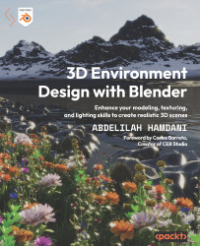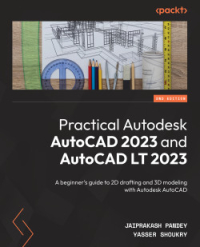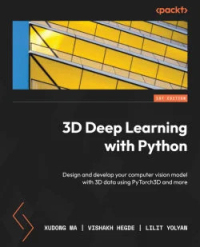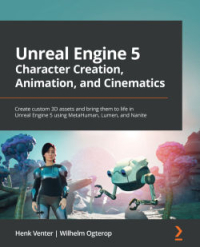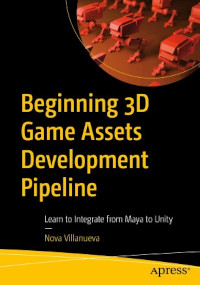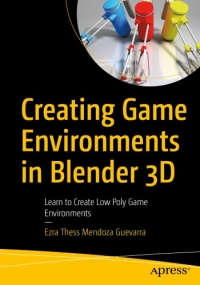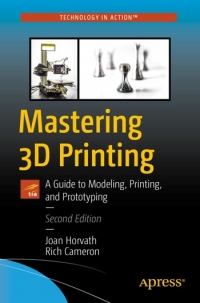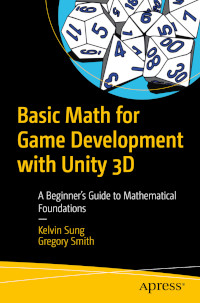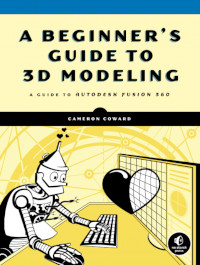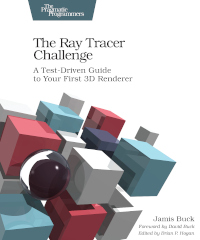3D eBooks
3D Environment Design with Blender
Blender is a powerful tool for creating all kinds of visual assets, but with such power comes complexity. Creating a photorealistic 3D scene seems like a Herculean task for more than 90% of 3D designers, but don't be discouraged! 3D Environment Design with Blender will get you up and running. This practical guide helps reduce the complexity of 3D environment design, advance your Blender skills, and produce lifelike scenes and animations in a time-efficient manner. You'll start by learning how to fix the most common mistakes 3D designers make with modeling and scale matching that stop them from achieving photorealism. Next, you'll understand the basics of realistic texturing, efficient unwrapping and achieving photorealistic lighting by turning an actual reference of a wood cabin into a realistic 3D scene. These skills will be used and expanded as you build a realistic 3D environment with natural assets and materials that you'll create fr ...
Blender is a powerful tool for creating all kinds of visual assets, but with such power comes complexity. Creating a photorealistic 3D scene seems like a Herculean task for more than 90% of 3D designers, but don't be discouraged! 3D Environment Design with Blender will get you up and running. This practical guide helps reduce the complexity of 3D environment design, advance your Blender skills, and produce lifelike scenes and animations in a time-efficient manner. You'll start by learning how to fix the most common mistakes 3D designers make with modeling and scale matching that stop them from achieving photorealism. Next, you'll understand the basics of realistic texturing, efficient unwrapping and achieving photorealistic lighting by turning an actual reference of a wood cabin into a realistic 3D scene. These skills will be used and expanded as you build a realistic 3D environment with natural assets and materials that you'll create fr ...
Mathematics for Game Programming and Computer Graphics
Mathematics is an essential skill when it comes to graphics and game development, particularly if you want to understand the generation of real-time computer graphics and the manipulation of objects and environments in a detailed way. Python, together with Pygame and PyOpenGL, provides you with the opportunity to explore these features under the hood, revealing how computers generate and manipulate 3D environments. Mathematics for Game Programming and Computer Graphics is an exhaustive guide to getting "back to the basics" of mathematics, using a series of problem-based, practical exercises to explore ideas around drawing graphic lines and shapes, applying vectors and vertices, constructing and rendering meshes, and working with vertex shaders. By leveraging Python, Pygame, and PyOpenGL, you'll be able to create your own mathematics-based engine and API that will be used throughout to build applications. By the end of this graphics focussed book, you'll have gained a thoro ...
Mathematics is an essential skill when it comes to graphics and game development, particularly if you want to understand the generation of real-time computer graphics and the manipulation of objects and environments in a detailed way. Python, together with Pygame and PyOpenGL, provides you with the opportunity to explore these features under the hood, revealing how computers generate and manipulate 3D environments. Mathematics for Game Programming and Computer Graphics is an exhaustive guide to getting "back to the basics" of mathematics, using a series of problem-based, practical exercises to explore ideas around drawing graphic lines and shapes, applying vectors and vertices, constructing and rendering meshes, and working with vertex shaders. By leveraging Python, Pygame, and PyOpenGL, you'll be able to create your own mathematics-based engine and API that will be used throughout to build applications. By the end of this graphics focussed book, you'll have gained a thoro ...
Practical Autodesk AutoCAD 2023 and AutoCAD LT 2023, 2nd Edition
AutoCAD is one of the most versatile software applications for architectural and engineering designs and the most popular computer-aided design (CAD) platform for 2D drafting and 3D modeling. This hands-on 2nd edition guide will take you through everything you need to know to make the most out of this powerful tool, from a simple tour of the user interface to using advanced tools. Starting with basic drawing shapes and functions, you'll get to grips with the fundamentals of CAD designs. You'll then learn about effective drawing management using layers, dynamic blocks, and groups, and discover how to add annotations and plots like a professional. As you progress, the book will show you how to convert your 2D drawings into 3D models and shapes. You'll also discover advanced features, such as isometric drawings, drawing utilities for managing and recovering complex files, quantity surveying, and multidisciplinary drawing files using xRefs. Finally, you'll focus on renderi ...
AutoCAD is one of the most versatile software applications for architectural and engineering designs and the most popular computer-aided design (CAD) platform for 2D drafting and 3D modeling. This hands-on 2nd edition guide will take you through everything you need to know to make the most out of this powerful tool, from a simple tour of the user interface to using advanced tools. Starting with basic drawing shapes and functions, you'll get to grips with the fundamentals of CAD designs. You'll then learn about effective drawing management using layers, dynamic blocks, and groups, and discover how to add annotations and plots like a professional. As you progress, the book will show you how to convert your 2D drawings into 3D models and shapes. You'll also discover advanced features, such as isometric drawings, drawing utilities for managing and recovering complex files, quantity surveying, and multidisciplinary drawing files using xRefs. Finally, you'll focus on renderi ...
3D Deep Learning with Python
With this hands-on guide to 3D deep learning, developers working with 3D computer vision will be able to put their knowledge to work and get up and running in no time. Complete with step-by-step explanations of essential concepts and practical examples, this book lets you explore and gain a thorough understanding of state-of-the-art 3D deep learning. You'll see how to use PyTorch3D for basic 3D mesh and point cloud data processing, including loading and saving ply and obj files, projecting 3D points into camera coordination using perspective camera models or orthographic camera models, rendering point clouds and meshes to images, and much more. As you implement some of the latest 3D deep learning algorithms, such as differential rendering, Nerf, synsin, and mesh RCNN, you'll realize how coding for these deep learning models becomes easier using the PyTorch3D library. By the end of this deep learning book, you'll be ready to ...
With this hands-on guide to 3D deep learning, developers working with 3D computer vision will be able to put their knowledge to work and get up and running in no time. Complete with step-by-step explanations of essential concepts and practical examples, this book lets you explore and gain a thorough understanding of state-of-the-art 3D deep learning. You'll see how to use PyTorch3D for basic 3D mesh and point cloud data processing, including loading and saving ply and obj files, projecting 3D points into camera coordination using perspective camera models or orthographic camera models, rendering point clouds and meshes to images, and much more. As you implement some of the latest 3D deep learning algorithms, such as differential rendering, Nerf, synsin, and mesh RCNN, you'll realize how coding for these deep learning models becomes easier using the PyTorch3D library. By the end of this deep learning book, you'll be ready to ...
Unreal Engine 5 Character Creation, Animation, and Cinematics
Unreal Engine 5 (UE5) offers beginners and seasoned professionals the ability to create detailed movie scenes with realistic human characters using MetaHuman and combine it with custom props and environments. It also comes with built-in industry standard animation tools to develop such scenes in a fraction of the time compared to old methods. This book takes you through the entire 3D movie production pipeline using free (open - source) software. By following the step-by-step, beginner-friendly tutorials in this book, you'll learn how to create your own custom 3D assets in Blender and texture these 3D assets in Quixel Mixer. Next, you'll take these completed 3D assets into Unreal Engine 5 and use them to build a virtual 3D movie set for your 3D movie. You'll also populate your 3D movie set by using Quixel MegaScans assets and create and customize your own photorealistic human character using MetaHuman Creator and UE5. As you advance, y ...
Unreal Engine 5 (UE5) offers beginners and seasoned professionals the ability to create detailed movie scenes with realistic human characters using MetaHuman and combine it with custom props and environments. It also comes with built-in industry standard animation tools to develop such scenes in a fraction of the time compared to old methods. This book takes you through the entire 3D movie production pipeline using free (open - source) software. By following the step-by-step, beginner-friendly tutorials in this book, you'll learn how to create your own custom 3D assets in Blender and texture these 3D assets in Quixel Mixer. Next, you'll take these completed 3D assets into Unreal Engine 5 and use them to build a virtual 3D movie set for your 3D movie. You'll also populate your 3D movie set by using Quixel MegaScans assets and create and customize your own photorealistic human character using MetaHuman Creator and UE5. As you advance, y ...
Beginning 3D Game Assets Development Pipeline
This project-based tutorial covers the creation of 3D assets in a game engine, from concept to implementation. You will learn the 3D pipeline using Maya and Substance Painter, which are industry-standard programs used for content creation in game development. You also will know how to add them and work with them in Unity. The book begins with an overall look at the production of game development and the different roles in creating assets. Then, starting with Maya, you learn how to start with a concept and take it through the entire production pipeline: base mesh, UV mapping, high poly, texturing, rigging, and animation. You will be working on one asset project throughout the entire book to understand how one phase leads to the next one. Lastly, you will cover asset placement and integration into Unity. ...
This project-based tutorial covers the creation of 3D assets in a game engine, from concept to implementation. You will learn the 3D pipeline using Maya and Substance Painter, which are industry-standard programs used for content creation in game development. You also will know how to add them and work with them in Unity. The book begins with an overall look at the production of game development and the different roles in creating assets. Then, starting with Maya, you learn how to start with a concept and take it through the entire production pipeline: base mesh, UV mapping, high poly, texturing, rigging, and animation. You will be working on one asset project throughout the entire book to understand how one phase leads to the next one. Lastly, you will cover asset placement and integration into Unity. ...
Creating Game Environments in Blender 3D
Discover how to create a simple game environment in Blender 3D from modeling and texturing game assets, to placing them in a scene. You'll export and import game assets as well as look at open-source game engines that will work with your game assets. Creating Game Environments in Blender 3D introduces the power of Blender 3D when creating a low poly game environment. The book starts by discussing the basics of game terminology, such as knowing the difference between low poly and high poly assets and the types of game you're likely to work on. You'll also take a brief look at Blender's background and installation. The following chapters talk about the process for creating a simple game environment. This is discussed in detail along with a sample project. These chapters discuss the common tools for starting a game environment and the methods for enhancing your game environment, such as color fundamentals. The final chapter shows how you can export the game assets ...
Discover how to create a simple game environment in Blender 3D from modeling and texturing game assets, to placing them in a scene. You'll export and import game assets as well as look at open-source game engines that will work with your game assets. Creating Game Environments in Blender 3D introduces the power of Blender 3D when creating a low poly game environment. The book starts by discussing the basics of game terminology, such as knowing the difference between low poly and high poly assets and the types of game you're likely to work on. You'll also take a brief look at Blender's background and installation. The following chapters talk about the process for creating a simple game environment. This is discussed in detail along with a sample project. These chapters discuss the common tools for starting a game environment and the methods for enhancing your game environment, such as color fundamentals. The final chapter shows how you can export the game assets ...
Mastering 3D Printing, 2nd Edition
Get the most out of your printer, including how to design models, choose materials, work with different printers, and integrate 3D printing with traditional prototyping to make techniques like sand casting more efficient.This book is for new 3D printer owners, makers of all kinds, entrepreneurs, technology educators, and anyone curious about what you can do with a 3D printer. In this revised and expanded new edition of Mastering 3D Printing, which has been a trusted resource through five years of evolution in the 3D printing industry, you'll gain a comprehensive understanding of 3D printing. This book presumes no foreknowledge and describes what you need to know about how printers work, how to decide which type of printer (filament, resin, or powder) makes the most sense for you, and then how to go forward in the case of filament and resin printers. This 2nd edition includes material about consumer resin printing, the evolution of lower-co ...
Get the most out of your printer, including how to design models, choose materials, work with different printers, and integrate 3D printing with traditional prototyping to make techniques like sand casting more efficient.This book is for new 3D printer owners, makers of all kinds, entrepreneurs, technology educators, and anyone curious about what you can do with a 3D printer. In this revised and expanded new edition of Mastering 3D Printing, which has been a trusted resource through five years of evolution in the 3D printing industry, you'll gain a comprehensive understanding of 3D printing. This book presumes no foreknowledge and describes what you need to know about how printers work, how to decide which type of printer (filament, resin, or powder) makes the most sense for you, and then how to go forward in the case of filament and resin printers. This 2nd edition includes material about consumer resin printing, the evolution of lower-co ...
Basic Math for Game Development with Unity 3D
Use Unity-based examples to understand fundamental mathematical concepts and see how they are applied when building modern video game functionality. You will gain the theoretical foundation you need, and you will know how to examine and modify an implementation. This book covers points in a 3D Cartesian coordinate system, and then discusses vectors and the details of dot and cross products. Basic mathematical foundations are illustrated through Unity-based example implementations. Also provided are examples showing how the concepts are applied when implementing video game functionality, such as collision support, motion simulations, autonomous behaviors, shadow approximations, and reflection off arbitrary walls. Throughout this book, you learn and examine the concepts and their applications in a game engine. Understand the basic concepts of points and vectors and their applications in game development; Apply mathematical concepts to modern video game functionality, such ...
Use Unity-based examples to understand fundamental mathematical concepts and see how they are applied when building modern video game functionality. You will gain the theoretical foundation you need, and you will know how to examine and modify an implementation. This book covers points in a 3D Cartesian coordinate system, and then discusses vectors and the details of dot and cross products. Basic mathematical foundations are illustrated through Unity-based example implementations. Also provided are examples showing how the concepts are applied when implementing video game functionality, such as collision support, motion simulations, autonomous behaviors, shadow approximations, and reflection off arbitrary walls. Throughout this book, you learn and examine the concepts and their applications in a game engine. Understand the basic concepts of points and vectors and their applications in game development; Apply mathematical concepts to modern video game functionality, such ...
A Beginner's Guide to 3D Modeling
A Beginner's Guide to 3D Modeling is a project-based, straightforward introduction to computer-aided design (CAD). You'll learn how to use Autodesk Fusion 360, the world's most powerful free CAD software, to model gadgets, 3D print your designs, and create realistic images just like an engineering professional - with no experience required! Hands-on modeling projects and step-by-step instructions throughout the book introduce fundamental 3D modeling concepts. As you work through the projects, you'll master the basics of parametric modeling and learn how to create your own models, from simple shapes to multipart assemblies. Once you've mastered the basics, you'll learn more advanced modeling concepts like sweeps, lofts, surfaces, and rendering, before pulling it all together to create a robotic arm. You'll learn how to: Design a moving robotic arm, a door hinge, a teapot, and a 20-sided die; Create professional technical drawings for manufacturing and patent a ...
A Beginner's Guide to 3D Modeling is a project-based, straightforward introduction to computer-aided design (CAD). You'll learn how to use Autodesk Fusion 360, the world's most powerful free CAD software, to model gadgets, 3D print your designs, and create realistic images just like an engineering professional - with no experience required! Hands-on modeling projects and step-by-step instructions throughout the book introduce fundamental 3D modeling concepts. As you work through the projects, you'll master the basics of parametric modeling and learn how to create your own models, from simple shapes to multipart assemblies. Once you've mastered the basics, you'll learn more advanced modeling concepts like sweeps, lofts, surfaces, and rendering, before pulling it all together to create a robotic arm. You'll learn how to: Design a moving robotic arm, a door hinge, a teapot, and a 20-sided die; Create professional technical drawings for manufacturing and patent a ...
The Ray Tracer Challenge
Brace yourself for a fun challenge: build a photorealistic 3D renderer from scratch! It's easier than you think. In just a couple of weeks, build a ray tracer that renders beautiful scenes with shadows, reflections, brilliant refraction effects, and subjects composed of various graphics primitives: spheres, cubes, cylinders, triangles, and more. With each chapter, implement another piece of the puzzle and move the renderer that much further forward. Do all of this in whichever language and environment you prefer, and do it entirely test-first, so you know it's correct. Recharge yourself with this project's immense potential for personal exploration, experimentation, and discovery. The renderer is a ray tracer, which means it simulates the physics of light by tracing the path of light rays around your scene. Each exciting chapter presents a bite-sized piece of the puzzle, building on earlier chapters and setting the stage for later ones. Requirements are given language-agnosti ...
Brace yourself for a fun challenge: build a photorealistic 3D renderer from scratch! It's easier than you think. In just a couple of weeks, build a ray tracer that renders beautiful scenes with shadows, reflections, brilliant refraction effects, and subjects composed of various graphics primitives: spheres, cubes, cylinders, triangles, and more. With each chapter, implement another piece of the puzzle and move the renderer that much further forward. Do all of this in whichever language and environment you prefer, and do it entirely test-first, so you know it's correct. Recharge yourself with this project's immense potential for personal exploration, experimentation, and discovery. The renderer is a ray tracer, which means it simulates the physics of light by tracing the path of light rays around your scene. Each exciting chapter presents a bite-sized piece of the puzzle, building on earlier chapters and setting the stage for later ones. Requirements are given language-agnosti ...
